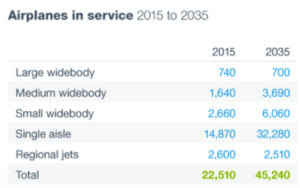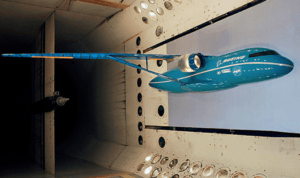The Future of Flight: Boeing’s Emissions Battle

Commercial aviation has created a more connected world, but can we cope with the side effects of this increasingly accessible luxury?
Aviation is on a growth path that is nearly stratospheric. In a rare case, Boeing and Airbus agree that the future is bright with a projected doubling of commercial aircraft in service1.
Tied to the massive growth in aviation is increased greenhouse emissions occurring with every flight (along with the energy used for manufacturing). Boeing Commercial Airplanes’ goal to create more fuel efficient aircraft is a solution that benefits both the environment and Boeing’s customers, as fuel is the No. 1 cost, overtaking labor costs years ago, for an airline2. As a result, 10-15% increases in fuel efficiency of derivative airplanes and (ideally) 20-25% increases in fuel efficiency of all new airplane programs are a logical business step without even considering climate change1.
Climate Change
Viewed in isolation, these fuel efficiency improvements seem outstanding, however a broader context shows “aviation is currently responsible for 2% of global emissions and… if left unregulated, aviation emissions have been projected to account for as much as 22% of global emissions by 2050”3. As a result, regulation has been put in place by the International Civil Aviation Organization (ICAO) with over 60 countries committing to “carbon neutral growth” in international flights after 20214. This is not a perfect measure, but it is a start.
Current Solutions
In order to cooperate with the existing regulations and to help airlines to meet them as well, Boeing begun several initiatives. Operationally, Boeing’s 737 plant in Washington and 787 plant in South Carolina are powered entirely by renewable sources. On the airline side, Boeing is partnering with multiple companies on biofuel research to utilize in jet engines (with commercial tests being completed using up to 15% biofuel). Boeing is also working with government entities to make airspace more efficient, such as arrival procedures that cut fuel use 400 to 600 pounds per arrival (1,900 pounds of carbon dioxide emissions)1.  Lastly, Boeing has created three flying test beds to accelerate the development of over 50 separate technologies in a program called the ecoDemonstrator (seen here: https://www.youtube.com/watch?v=tQM8XiGxSQM).
Lastly, Boeing has created three flying test beds to accelerate the development of over 50 separate technologies in a program called the ecoDemonstrator (seen here: https://www.youtube.com/watch?v=tQM8XiGxSQM).
Issues
All of these measures are positive, however only with impeccable execution across all initiatives, will the new regulations be met. The first issue that has become abundantly clear is a fundamental flaw in Boeing’s product development process. The research and development costs for new airplanes have grown at a backbreaking exponential rate with the latest program, the 787, running at least $32 billion over budget5. Without execution, the company will fail on its next new airplane. As important, the time to market of a new airplane is 5-10 years with each program being run for roughly 20 years, and an individual airplane’s life span set conservatively at 25 years. Consequently, currently new airplane lines will likely be around for another 45 years, painting a bleak picture of innovation. Long shot projects are few and far between, such as the Subsonic Ultra Green Aircraft Research (SUGAR, seen below) which had aimed for 60% fuel reduction in the 2030-2035 timeframe6. Realistically, SUGAR is unlikely to be produced for many years. Unfortunately, the only game-changing innovation since the jet engine 50 years ago has been carbon composite airplane fuselages. Massive new innovations are necessary to keep increasing fuel efficiency at the same rate.
Another core issue is airspace’s lack of efficiency. Boeing has made strides with flight path optimization as mentioned above, but the FAA controls the majority stake in the US. Air traffic management has been undergoing an upgrade called NextGen. This $40 billion program has already spent $6 billion with little to show for its efforts aside from scathing reviews and critics calling for the privatization of air traffic management7. Overhauling a system crucial to public safety, yet integral to unlocking huge efficiencies in route optimization and emissions reduction has left the government making miniscule changes.
What now?
Boeing’s, and aviation’s, path to the future lies in a more agile product development process with leaner teams on a shorter schedule. An increased use of Performance Improvement Packages would allow Boeing to place new innovations on older airplanes. You cannot gamble with human safety, but Boeing increasing flying test bed work while more tightly partnering with the FAA will be the only way for the company as we know it to survive. Boeing also needs to force engine companies to continue to innovate as quickly as in the past, with ~1% efficiency gains per year being a bare minimum for continued success8. Lastly, Boeing needs to continue to spend on moon shot concepts because if there is no dramatic change in aircraft design then the ability to find incremental improvements diminishes with time. If Boeing does not make changes to its process in the near term, either emissions will continue to skyrocket or a new player will penetrate the market to fill that void.
(800 words)
1 “The Boeing Company 2016 Environment Report.” The Boeing Company, n.d. Web. 2 Nov. 2016.
2 “TRAVEL; Airlines keep adapting to high fuel costs.” The Atlanta Journal-Constitution. (March 4, 2012 Sunday ): 879 words. LexisNexis Academic. Web. Date Accessed: 2016/11/01.
3 “China a Key Player in Aviation Emissions Agreement.” US Official News. (September 15, 2016 Thursday ): 1978 words. LexisNexis Academic. Web. Date Accessed: 2016/11/01.
4 “Grading the Airlines’ Climate Agreement: Historic Steps, Missed Opportunities.” US Official News. (October 14, 2016 Friday ): 1361 words. LexisNexis Academic. Web. Date Accessed: 2016/11/01.
5 Bryant, Chris. “Boeing’s $32 Billion Accounting Question.” Bloomberg Gadfly. N.p., 14 Apr. 2016. Web. 02 Nov. 2016.
6 “NASA, Boeing Test Low-Drag Truss-Braced Wing Concept.” Aviation Week. N.p., 27 Jan. 2014. Web. 03 Nov. 2016.
7 Halsey, Ashley. “Panel Says New Air-traffic Control System Not Delivering What Was Promised.” The Boston Globe. The Washington Post, 2 May 2015. Web. 2 Nov. 2016.
8 “Aircraft Geared Architecture Reduces Fuel Cost and Noise.” NASA, n.d. Web. 02 Nov. 2016.
Pictures (in order of appearance)
1 “NASA’s Big Ideas for the Future of Flight.” CBSNews. N.p., n.d. Web. 02 Nov. 2016.
2 “The Boeing Company 2016 Environment Report.” The Boeing Company, n.d. Web. 2 Nov. 2016.
3 “The Boeing Company 2016 Environment Report.” The Boeing Company, n.d. Web. 2 Nov. 2016.
4 “NASA, Boeing Test Low-Drag Truss-Braced Wing Concept.” Aviation Week. N.p., 27 Jan. 2014. Web. 03 Nov. 2016.





I never realized how much the flight industry contributed to emissions but now it seems so obvious. I think as the world becomes more and more global, this problem will only get more exacerbated. So its imperative that Boeing and other manufacturers take action now. The research into high performance bio-fuels needs to be top priority and the industry needs to come together to do it.
Corey, I’m interested to hear your thoughts on how these issues apply to Boeing’s defense business, which is poised to grow as the U.S. and Western militaries start to replace aging airfleets. Most of the Air Force’s aircraft, for example, are 30+ years old, some some approaching 60 years old (https://www.planespotters.net/airline/USAF-United-States-Air-Force). Military aircraft tend to fly inefficient routes and burn a ton of fuel (much of which is dumped prior to landing to reduce weight). Additionally, the defense acquisitions process has undergone and will continue to undergo changes that shift some R&D costs to manufacturers in order to disincentivize cost overruns. That seems to emphasize your final conclusion to an even greater degree.
Aside from the aircraft weight reductions associated with carbon composite airframes like the 787, isn’t much of the energy efficiency and biofuel advancement squarely in the lane of the engine manufacturers like GE and Rolls Royce, or is that up to Boeing and Airbus to pioneer? My understanding was that most of the PIPs were largely about re-engining.
Boeing Commerical Airplanes and Boeing Defense, Space & Security are essentially two separate companies that are combined under one umbrella, which can help with some technology efficiencies. Military aircraft typically place performance, in terms of range and speed (and agility and stealth for fighters) as the first priority and fuel burn is a fallout of the equation. Some products are a combination product such as the P-8 Poseidon, which is a modified 737 for anti-submarine warfare and intelligence, and the KC-46 tanker which benefit from the fuel burn improvements of the commercial plane.
In terms of PIPs, historically it is shared benefits between aerodynamic and weight improvements and engine improvements as seen recently with the 777 PIP (http://aviationweek.com/advanced-machines-aerospace-manufacturing/boeing-ge-define-777-performance-upgrade). The 747 PIP (https://www.flightglobal.com/news/articles/boeing-conducts-test-flight-of-747-8-with-pip-386173/) was largely engine based as you noted. Boeing and the engine manufacturers partner incredibly closely in order to integrate the full product as tightly as possible. Biofuels benefit the entire industry, so Boeing has partnered with airlines like Alaska Airlines (http://boeing.mediaroom.com/Port-of-Seattle-Partners-with-Alaska-Airlines-and-Boeing-on-Plan-to-Supply-Sustainable-Aviation-Biofuel-at-Sea-Tac-Airport), engine companies and really anyone involved in the supply chain.
Fantastic read Cory!
At this point, commercial regulation is essentially unregulated when it comes to the environment. Boeing wields considerable influence politically due to their role as the USA’s largest exporter of planes (by dollar). Boeing has been helping write new aviation emissions guidelines that don’t have much bite. If Boeing was actually interested in driving sustainability and staving off climate change, as opposed to simply increasing their bottom line, why do you think they aren’t pressing the EPA to craft more stringent emissions regulations?
Commercial aviation, not “commercial regulation” in the first sentence.
I really appreciated the way you connected innovation in aerospace industry to flaws in Boeing’s product development process. It would be nice to know what Boeing’s current system for product development consists of. I assume that they have some type of stage gate design process with pretty rigorous gates, but it would be interesting to see if they are actually following whatever process they have. Also, does Boeing ever attempt to innovate through partnerships with its upstream suppliers? It seems like the aerospace industry as a whole could benefit from increased partnerships between OEM’s and suppliers considering the there are so many players in more supply chains and each has very specific expertise. While I was working in the industry I didn’t see very much effective collaboration, but I wonder if this could be a solution to more cost effective and time sensitive innovation.
A recent development is the aerospace industry is that supersonic flights may be coming back soon. (http://www.vox.com/energy-and-environment/2016/11/2/13409324/supersonic-flight-concorde). NASA and a significant number of aviation startups are re-experimenting with supersonic planes (the very concept that made Concord bankrupt decades ago), citing drastic improvements in fuel efficiency, drag-reduction technologies, and effective mitigation of the once-disruptive sonic waves. The upside? San Francisco to Tokyo in 4 hours (instead of 11), and New York to London in 3 hours (instead of 8). It would be interesting to see how Boeing reacts to the resurgence of commercial supersonic flights. How would Boeing adjust their sustainability strategy to the evolving competitive landscape of commercial flights?
Thanks CK for your thoughtful research and blogpost.
Interesting read. Few observations:
The aviation industry seems to be a major contributor to climate change, but is not affected itself by it by the same order of magnitude. Hence, the incentives for them to reduce their negative impact on climate change is not as strong. Don’t you think that in such a scenario that government should step in and offer heavy subsidies for such programs?
Moreover, Boeing and other major companies are asked to maximize value to their shareholders, and hence to take advantage of the current cheap oil. By asking Boeing to invest in such technologies that are more friendly to the environment, I am afraid we are asking them to sacrifice their share holders’ interest (at least in the short to mid-term). However, shareholders might have a short to mid view on the stock and might not be interested in such programs. What are your views on that?
Finally, I wonder: are there any other disruptive approaches to reduce emissions in aviation industry other than the ones you mentioned? For example, is there any experiments or ideas about nuclear powered airplanes?